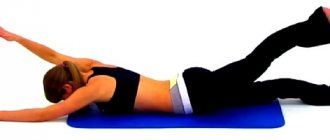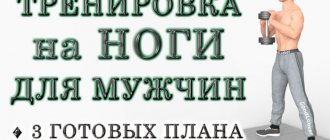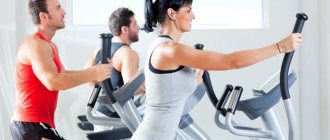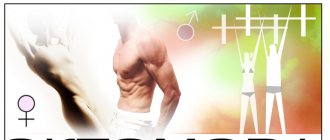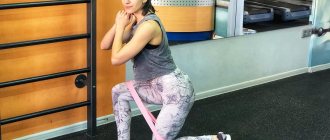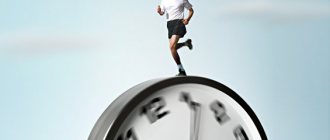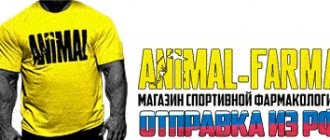Anatomy of the legs
It is unlikely that you can use anything to its full potential without studying the detailed instructions. With exercises for the legs, things are just the same. It is impossible to get the full benefit from each repetition and approach without understanding how the muscles being pumped work. Of course, a thorough study of the function and structure of each muscle is not necessary, but in general terms the structure and task of each muscle zone must be understood.
If we evaluate in general, the concept of “legs” is divided into the following muscles, each of which requires separate exercises:
- Quadriceps femoris muscle (quadriceps) – extends the leg at the knee, takes part in tilting the pelvis forward;
- Biceps femoris muscle (femoral biceps) – bends the leg at the knee, participates in extension of the body;
- The gluteus maximus, medius and minimus muscles (buttocks) – straightening the torso and moving the legs back;
- Gastrocnemius and soleus muscles (calves) - flexion at the ankle joint.
Each group consists of several muscles. For example, the quadriceps muscle includes 4 heads, the biceps, respectively, two bundles. This also needs to be taken into account, because to pump some heads you will have to use separate exercises.
Myths about pumping legs
A lot of myths have formed in strength sports that significantly distort the idea of what proper leg muscle training should look like. As a result, massive and strong legs are very rare among athletes. Many athletes spend time and a lot of effort doing grueling workouts, but do not get even 50% of the desired result. Therefore, it is very important to dispel the main myths regarding leg exercises that bodybuilding accumulates every year.
Myth #1 – You can’t build powerful legs without “secret techniques”
The lack of results for many athletes makes them believe that without “secret techniques” that only professionals know, it is impossible to pump up their legs. However, the reason for such theories is the numerous mistakes that are made not only at the stage of thinking through micro and macro cycles, but also in each individual workout. Add to this technical flaws in the process of performing exercises and you get a formed reason for the failures of tens of thousands of athletes.
Myth No. 2 – The monotony of training does not hinder progress.
Leg muscles are no different from other muscle groups, so any monotony will reduce the rate of progression. As a result, muscle and strength growth will slow down significantly, even if you do the most effective leg exercises every workout. Try to add variety to your training, use different styles (strength, high-repetition, static-dynamic, etc.), include supersets, dropsets and other techniques at least once every two weeks. This will help avoid adaptation, as a result of which the muscles will respond with growth to the received load.
Myth #3 – Squats alone are enough
Of course, barbell squats are one of the cornerstones of all strength sports. Only a couple of other movements can compete with squats in terms of efficiency and benefits. However, squats alone are not enough. Otherwise, everyone would only do one exercise and get huge legs. Remember that leg training is the most voluminous in terms of the number of exercises and load. This is the only way to achieve the desired growth in strength and mass.
Otherwise, it’s enough to train regularly, remember to rest and, of course, provide your muscles with everything they need for growth with the help of quality nutrition.
Leg training program
Now we will bring to your attention a very effective training program for legs. We will not describe the program for beginners, since they only need classic squats. This program will be intended for athletes who have been training for more than six months:
- Squats with a barbell on your shoulders - 3 sets of 8-10 reps.
- Leg press - 3 times 12-15 times.
- Leg curls in the simulator - 3 sets of 12-15 times.
- Working out the calf muscles - 3 sets of 20-25 repetitions.
You need to train with this program once a week. Every 2 months you need to do a workout with light weights and a high number of repetitions . If such high-intensity training takes place in your training process, that’s very good. After all, they perfectly stimulate the growth of muscle mass in the legs and help awaken “dormant” muscle fibers.
Recommendations from professionals
Training the leg muscles of professional athletes is not always an example of ideal work in the gym. It is important to understand that pros have their own priorities and realities, which will not always be relevant. However, some rules and training features for experienced athletes help to correctly use their efforts in the gym and accelerate progression.
#1 – Focus on powerful compound exercises
The more muscle fibers involved during an exercise, the better. And not only for the legs, but also for all the muscles of the body. Therefore, try to pay maximum attention to squats, Romanian deadlifts, lunges and other volumetric movements.
No. 2 – Properly combine basic and isolation exercises
It is important to find a balance between different techniques, exercises, types of load, etc. Try to perform basic exercises with heavy weights in the first half of the workout, when the energy reserves of the muscles have not yet been used up. Isolation movements are best used in the second half of the workout, as finishing moves for a specific muscle or area.
#3 - Don't exercise too often
It is important to take into account the features of leg training when thinking through a program in cycles. The muscle group recovers the slowest, and the legs are constantly under stress throughout the day. This further extends the recovery time. Therefore, think over your rest so that your legs are fully restored between workouts.
#4 – Remember Muscle Balance
Imbalance in muscle development always leads to a slowdown or complete stop of progression. This is a dead-end path, as a result of which you are guaranteed to have to devote months to tighten up lagging muscles. Remember that strength exercises for the legs and buttocks should involve all the muscles of the lower body.
#5 – There are no bad exercises, only incorrect execution.
This suggests that technology is paramount. If some exercise has become popular over the decades of development of strength sports, then it will definitely be used. But only if all technical conditions are met. For example, when you round your back, the Romanian deadlift immediately loses at least half of its effectiveness.
Follow these tips, approach your training wisely and with knowledge of theory, and you will be guaranteed an increase in mass and strength.
What do we need for proper leg training?
- Correctly selected exercises . We have already decided that the priority will be basic exercises. They will help build muscle mass.
- Progression of loads. In order to avoid stagnation in muscle growth, we will need to constantly add working weight. Let it be little by little, 1 kg at a time, but the progression should be constant. Of course, under no circumstances approach this point with great fanaticism. We add weight gradually as you become more trained.
- Warm up at the beginning of the workout. This is a very important component in the training process. Warm-up will help warm up your muscles for hard work. The same applies to warm-up approaches.
- Stretching at the end of your workout. Remember once and for all - stretching is done only at the end of the workout! But why? Because during stretching, the muscle relaxes, which promotes its speedy recovery and minimizes muscle pain the next day after training. And also, it stretches the muscle fibers that remain in a bound state after hard work on the legs in the gym. If we stretch at the beginning, we will relax the muscles and they are unlikely to be able to work to their maximum.
- Periodization of loads. That is, alternating training on fast (BMW) and slow muscle fibers (MMF). What is the difference between them? BMWs are white and designed for hard work, but get tired quickly. Therefore, they are trained with heavy weights and a small number of repetitions from 1 to 5. MMV is red. On the contrary, they are designed for long work, but with much less weight. We will train them for a high number of repetitions with light weights for 15-20 repetitions.
- Maintaining training progress . Of course, you can skip this step if you have excellent memory and can store a lot of information. But for me it’s easier to write it down. A training notebook will help you with this. In it you will write down: controls, weights, approaches and number of repetitions. Also, your body parameters. Then after some period, for example a month, you will be able to evaluate your progress. It will be difficult to track it in your head.
We recommend reading: Should I pump up my abs every day?
Now that we know the training plan, we can start choosing the best exercises.
The best leg exercises
Now let's look at all the leg training exercises that you need to include in your training arsenal. They will be fully enough to progress for years, forgetting about stagnation and plateau. Compound and isolation movements need to be considered separately, so we'll divide the best exercises for leg mass into two categories.
Basic
The classification of basic movements is quite simple. These leg and glute workouts work multiple joints and a large number of muscle fibers. As a rule, this category includes the most complex and basic exercises in strength sports.
Squats with a barbell on your shoulders
For more than 50 years, the mainstay of leg training in any mass program has been squats. This is one of the most versatile movements in strength sports. It is important to understand that squat technique is critical.
Try to squat as low as possible while training your legs, this will engage your glutes and increase the effectiveness of the exercise.
Front Squats
In a leg program, changing the technique of some exercises can completely change the load received. Front squats are by no means an alternative to regular squats and it is incorrect to consider them only as a replacement. Among the obvious advantages are an increased load on the abdominal muscles, the ability to sit down much lower than with a barbell behind your back, as well as less load on the spinal column. This is one of the best exercises for developing leg mass, which can be performed with a barbell, sandbag, kettlebell and other equipment.
Leg press
Any athletes who know how to pump up their legs must do bench presses on the machine. This is an excellent mass-building exercise.
It is very important to adjust the chair correctly and perform the bench press to its full amplitude. Also remember that by placing your feet on the platform, you can change the load and switch it to individual muscles.
Lunges
Lunges are one of the most versatile movements. Such exercises for the leg muscles can be done both in the gym and at home. Moreover, there are many types of lunges (forward, backward, in place, curtsy, with a step to the side, etc.), which completely change the nature of the load. Thanks to this, you can specifically pump absolutely any muscle in the lower body.
Deadlift on straight legs
In terms of effectiveness for leg volume, this exercise comes immediately after squats. Moreover, most often it is combined with squats in supersets and complexes. Straight-legged deadlifts ideally develop the muscles of the buttocks, hamstrings and lower back.
It is important to remember that throughout the entire exercise your back should be perfectly straight. Any distortion will reduce the effectiveness of the traction and can lead to injury.
Hack squats
If the main goal in training is to develop exclusively the muscles of the legs, then hack squats can be an excellent alternative. Firstly, due to the locking of the core and the angle of movement, you can use much more weight than in squats. However, the main advantage of the exercise is the absence of severe stress on the spine.
Standing calf raise
Calves are the main sign of a pumped-up athlete who knows how to train his legs in the gym. Calf raises best replicate the basic function of the calves, which is why this exercise is considered one of the most suitable from an anatomical point of view.
Front Squats
To pump up your legs in the gym, a man needs a variety of loads and even the most effective exercises need to be modified. Changing the position of the barbell can cause many muscles to work completely differently, so try to alternate squats week by week, performing the exercise with the barbell on the front and on the back. It is not recommended to do both options in one workout.
Isolated
This category features leg strength exercises that primarily work only one joint.
Leg extensions
This exercise will always be on the list of the most effective isolation movements for training legs. Extensions are performed in a sitting position, as this allows you to eliminate as much as possible all muscles except the quadriceps.
It is important to remember that the movement uses the quadriceps muscle, so it is important to do it through the full amplitude. Also, you should not take too much weight; in extensions, priority should be given to technique and muscle concentration.
One leg extension
In some gyms, the equipment allows you to do single-leg extensions, which can be very useful for pumping up your legs. A similar technique, in which the entire approach is performed alternately on one leg and the other, makes the exercise more effective. Also, with a similar technique, you can do extensions more cleanly.
Lying leg curls
This is a classic hamstring workout for all bodybuilders, regardless of level. It is best to combine flexion with extension; working out the antagonist muscles significantly increases the benefits of both exercises.
It is important to remember that when performing the exercise, the gluteal muscles are also involved, which is why the movement is often used in circuit training and various complexes.
Seated leg curl
If your gym has a seated curl machine, add this exercise to your leg training routine. Performing curls while sitting is considered more comfortable and allows you to better load the hamstrings, leaving your buttocks out of the work.
Toe press in the simulator
If you need a hard calf workout while training your legs, then your best bet is to use a bench press machine. This will help you lift significant weight without the risk of injury. It is important to remember that you should always install the clamps; this will help you give your all without fear of tearing the platform down.
Standing leg curl
Such simulators are found only in advanced gyms. If it is possible to perform standing bends, then be sure to train in this style and include the exercise in your training program. This is a good option for adding variety to your curls at the gym.
Leg muscle exercises for men
Basic leg exercises
Squats
Squats are one of the main leg exercises that are aimed at developing volume and strength. With the correct technique and full range of motion, it works the quadriceps, muscles of the back of the thigh and buttocks. The usual foot position when performing squats is slightly wider than shoulder width. You can point your toes out and spread your legs wider if you want to work the inside of your legs. You should be very careful when performing squats, as it is very easy to get injured. The key point to pay attention to is keeping your back straight throughout the exercise. To do this, you should tilt your head back a little and look to the side where the ceiling meets the wall. Another key point is to balance the bar during the exercise. To ensure balance, the weight should be placed on your heels, meaning you should be able to wiggle your toes during any phase of the exercise.
Squats with dumbbells
This is one of those exercises that is preferred by those who have back problems or do not have access to a power rack. Unlike regular squats, where the barbell rests on your shoulders or upper back, the depth of the squat in this exercise is limited by the position of the dumbbells. It is not recommended to use straps when working with heavy weights. If you want to lift more weight, do regular squats. Due to the difference in weight, dumbbell squats should be performed in a higher rep range, although not too high, since it is still a strength exercise.
Front Squats
In this exercise, the weight of the apparatus is not on the back, but on the upper chest and shoulders. The advantage of this position is that the weight does not put direct pressure on the spine. The exercise is suitable for those who have back pain. Front squats work the quadriceps better than regular squats. The only downside to this weight position is that it uses less work on the muscles of the buttocks and hamstrings compared to regular squats.
Smith machine squats
What makes the Smith machine attractive is that it reduces the risk of injury during exercise. When doing regular squats, you take a risk by swinging the weight back or forward. But because the Smith machine controls the movement of the apparatus, you don't have to worry about balancing the weight. This control also allows you to lower yourself into a deeper squat, which works the hamstrings and buttocks well. Smith machine squats have 2 disadvantages. The first is that a strictly defined movement may be uncomfortable for people who are not very flexible. The second is that, as with all exercises in the Smith machine, stabilizer muscles do not work in such squats, since the machine sets a strictly defined trajectory of movement of the bar.
Leg press
The leg press is one of the best exercises in the machine for building mass and strength. It mainly works the quadriceps. The muscles of the back of the thigh and buttocks also work here. The degree of activity of these muscles depends on the depth of the squat. The greater the range of motion, the more stress is placed on these muscles. As with squats, your feet should be shoulder-width apart with your toes pointing forward. This position can be changed to shift the load on certain muscles. Wide stance of the legs makes the muscles of the inner surface of the legs work more actively. If you want to focus on your quads, place your feet higher on the platform. This exercise is performed in 2 versions. In the first, you push the platform away from you, and in the second, you push off the platform to push the back of the machine back. In both options, the muscles work the same.
Hack squats
This exercise is similar to a regular squat, but the weight does not put direct pressure on the spine. The main load falls on the quadriceps, and the secondary load falls on the muscles of the back of the thigh and buttocks. You can place your feet higher on the platform to better work your quadriceps in the knee area.
Lunges with dumbbells
One of the best exercises for simultaneously working the quadriceps, hamstrings and buttocks. To ensure that all muscles are working at the same time, you must perform this exercise with a full range of motion. If you are lifting heavy weights, it is not recommended to lower your knee to the floor as this may be painful and lead to injury. Most often, lunges are done in place, but you can also move forward until you complete the required number of repetitions or walk a certain distance.
Quadriceps exercises
Leg extension in the simulator
This is one of the few exercises for the quadriceps. The exercise is isolating. The roller of the machine should be located in front of the legs just above the ankles. If the back of the machine is adjustable, then install it so that your back is completely adjacent to it and your buttocks are on the seat. You can put your hands on the handles of the exercise machine or simply lower them down.
Exercises for the muscles of the back of the thigh
Leg bending in the simulator
This is one of the main exercises for the leg muscles, which works the upper part of the hamstrings, as well as the buttocks in the upper phase of the exercise. Although the exercise is usually performed with two legs, you can do it with one leg if you want to work on proportions. If you have lower back problems, then you must be careful when performing this exercise. The stretch of leg extension, combined with the need to lift weights from this position, can cause lower back injury.
Standing leg curl
The exercise works the entire back of the thighs, as well as the muscles of the buttocks in the upper phase of the exercise. It is performed with one leg. The exercise is most often suitable for those who have injuries. The load on the lower back is reduced due to the fact that it is performed while standing and does not stretch the body as much as when performing lying leg curls. Standing leg curls involve weight plates, which means you'll be lifting the weight directly rather than pulling a cable like you would with a machine leg curl.
Deadlift on straight legs
This is one of the most advanced hamstring exercises. It is used to build strength and muscle mass in the back of the thighs. Feet should be shoulder-width apart, toes pointing forward. The exercise must be performed with heavy weight, so it is important to control each movement and not bend your lower back too much in the upper phase of the exercise. If you have a back injury, you should not perform this exercise. Instead, perform machine leg curls or standing leg curls.
Exercises for the calf muscles
Standing calf raise
This is one of the most common exercises for the calf muscles. The weight distribution of this machine is different from that of a leg press machine, which helps prevent back pain. When performing the exercise, your feet should be shoulder-width apart. Toes should point forward.
Calf raises on a leg press machine
This is one of the main exercises for increasing the size and strength of the calf muscles. It can be performed on different machines. The most common machine here is the leg press machine because it provides back support and the ability to handle very heavy weights. This machine has restraints on both sides. When doing leg presses, they should be removed, but when doing calf raises, you can leave them in place. This will provide additional safety when working with heavy weights. The usual stance for this exercise is slightly wider than shoulder width. Toes should point forward.
Seated calf raise
This is one of the simplest calf exercises. Feet should be shoulder-width apart, toes pointing forward. The difference between sitting up and standing up is the distribution of weight. When pressing in a machine, the load falls directly on the calves. In a sitting position, the weight rests on the knees, which forces the calves to work, without the participation of other muscles.
How to pump up your legs in the gym?
Now let's look at an example of a specific program in order to clearly understand how to pump up your legs in the gym. Of course, this does not mean that you need to use only one training plan. This leg training program will be an excellent basis; over time, you can add new exercises to it or replace individual movements with the same type.
For newbies
The program for beginners should be as simple as possible. The basis is made up of basic exercises; isolating movements are included in the training plan to a limited extent.
Girls can use cyclic training. But in this case, any circuit training for the legs and buttocks should also be based on basic exercises.
A beginner's basic workout should look like this:
- Squats with a barbell – 3*12, 10, 8;
- Romanian deadlift (on straight legs) – 3*12, 10, 8;
- Extensions in a sitting machine – 3*12, 10, 8;
- Bending in a lying machine – 3*12, 10, 8;
- Calf raises while standing or in a machine.
This plan allows beginners to train effectively for up to two years, making changes to the program every one and a half to two months.
For advanced
For experienced athletes, a weight training program for legs should include a more thorough workout of all leg muscles, so the number of exercises will be significantly higher.
It is also important to understand that monotonous exercises will not be enough. Microcycles need to be thought out in such a way that they include strength training of the legs combined with static-dynamic work, if we are talking about mass.
The basic program will look like this:
- Superset: barbell squats and Romanian deadlifts – 4*12, 10, 8, 6 for each movement;
- Lunges (alternate lunges forward and backward for weeks) – 4 * 12, 10, 8, 8 on each leg;
- Leg press;
- Seated leg extension;
- Lying leg curl
- Superset: standing calf raise, sitting calf raise with a barbell – 3*15, 12, 10.
This is a hard leg workout that is guaranteed to give results to experienced athletes who already have a good base and physical training. You also need to periodically add front squats and wide-legged squats to the program.
Leg training for men in the gym for experienced athletes
A leg training program for men in the gym for experienced athletes may also include exercises such as squats and deadlifts.
But there must be another exercise, either a squat type or a lunge type. Let's first look at a squat-type leg training exercise for men in the gym:
Squatting in a hack machine.
In order to diversify the effect on the thigh parts of the quadriceps, legs together, knees together. We squat quite deeply, the buttocks are much lower than the knee joint.
Why legs together to work more on the outer quadriceps. For those who have back problems, you cannot hang a lot of weight, but you need to work your hips. You can use a single leg hack squat.
The weight is three to four times less, but you can work your legs so well that they can barely walk. However, there is no load on the back.
You can do squats on a Smith machine for variety.
Compared to classic squats, the only good thing is that you can squat your legs together for the outer quadriceps. Or it is very convenient to squat your legs wide. For the inner thigh. In such positions in the Smith machine it is not difficult to maintain balance.
Another equivalent exercise is the leg press.
Less effective than squatting. But sometimes, for variety, or when you have back problems, you can introduce this exercise.
There is also a single leg press option.
To some extent, it allows you to work your hip better, because the amplitude of movement is greater than if you press with both legs. But the disadvantage is that more time is spent on this exercise.
Let's look at lunge-type leg training exercises for men in the gym that need to be added to one of the squats
Back lunges on the Smith machine.
The front leg rests more on the heel. So that the buttock receives most of the load.
Another exercise, especially relevant when it comes to drying. Because it's exhausting. Steps with dumbbells onto a bench.
Balance in the development of the stabilizer muscles is required. After 12 repetitions with dumbbells, your legs will fall off. An energy-intensive exercise, we recommend it during drying.
The next exercise is lunges in motion with dumbbells
.
A good exercise for the gluteal muscle. No other exercise will make your butt hurt as much as lunges. We don’t take an extra step, we immediately take a step forward.
Basic recommendations for leg training for men in the gym:
We perform the exercises at a slightly slower pace and with a deep amplitude. The selected weight should provide a reasonable amount of tension, but not to the point of failure. And not any exercises with wind acceleration in the movements and spreads of the legs.
How to speed up progress using sports nutrition?
It’s not for nothing that many athletes believe that training leg muscles is the most hellish job in the gym that you can imagine. It takes all your strength, requires long-term recovery and giving 200%. Using supplements can significantly speed up not only the rate of progression, but also muscle recovery. First of all, we are talking about the most necessary additives, the effect of which is undeniable:
- Whey Protein;
- Creatine;
- Vitamin and mineral complexes (in any season except summer, if the diet contains a lot of fruits and vegetables);
- Omega-3.
If, in addition to strength work, cardio is included, especially in the morning or evening, then before it you need to drink a portion of BCAA (it is advisable to choose those that contain glutamine).
Supplements that can directly improve performance include:
- Pre-workout complexes (caffeine + green tea can be used separately at the beginning of training);
- Beta-alanine;
- Arginine, to improve pumping.
Many athletes confirm that with such a set the training is superb and even the hardest leg workout will bring joy. If we consider the maximum, then we can add complexes for restoring and improving sleep, as well as CLA, to the list.
For those who are just deciding whether they need sports nutrition, we recorded a video below:
Summary
Remember that even the best leg training program will lose effectiveness over time due to muscle adaptation. To avoid such situations, it is best to use exercises that are similar in type (for example, back squats and front squats, hack machine, etc.). Otherwise, the right food, the right supplements, plenty of sleep and rest, this is the ideal growth formula.
0 37
Did you like the article? Share with friends:
We recommend reading:
How to pump up your legs at home - TOP exercises and effective complexes
How to pump up a girl’s arms at home – exercises with and without dumbbells
How to pump up your forearms at home - the best exercises
Exercises for hands to prevent sagging skin - pump up your hands at home!
Triceps on a block - types of pull-downs and extensions
Real Man's Leg Day: Why and how - Om Activ
Men, unlike women, need to strengthen their quadriceps muscles. And this is only the first rule, but not the last. What a real man's leg workout should be like, says a regular expert in the Be Strong column. Men, as a rule, bench press 60 kilograms, no less. With the same weight, they (we) usually work on the biceps. But they refuse to train their legs or, at best, work on their legs with the same weight as on their arms, chest or shoulders. But the volume of the muscles of the arms and legs is in no way equal, so the load on them must be distributed proportionally. This means that on your legs, work with a weight calculated according to the following formula: the weight that you proudly press from your chest + 60%. Just don’t start right away with heavy weights. And don’t look for excuses - the length of the limbs, of course, affects muscle volume, but in many ways this is a reason invented by tall guys who are simply lazy.
Squats
Perform a squat below parallel to the floor, the so-called deep squat. This is the most effective variation of the squat. As soon as your calf muscles touch your hamstrings, rise up.
Target: quadriceps (but all large muscle groups are involved).
Technique:
● Keep your knees straight. ● Keep your back straight, do not round it. ● Make sure that your shoulders and knees do not protrude forward. ● Do not lift your heels off the floor. ● Choose adequate weights.
The barbell can be placed both on the trapezius and deeper, on the back and rear deltoids. It all depends on the working weight and the squatting technique. The wide lifter squat is performed with a deep landing.
Front squats with barbell
When the bar is located in front of the chest, the thigh works more isolated, the load shifts closer to the knee, since in this position the gluteal muscle cannot provide the same help as with a classic squat.
Target: quadriceps (lower knee joint).
Technique:
● Do not place the bar on your shoulders, it should be on your upper pectorals and front deltoids. You simply won't have enough arm strength if you hold the bar on your shoulders, and if you drop your elbows, you'll drop the apparatus. ● Keep your back straight, your knees do not go beyond the line of your toes.
Seated leg press in a machine
The exercise is ideal for refining the leg muscles after a squat or as a replacement for squats for those who have back problems that prohibit axial loads. Here the load is distributed in the same way as in regular squats, depending on the placement of the feet: wide (inner buttocks), narrow (external fascia lata), medium (total load).
Target: quadriceps, biceps, glutes.
Technique:
● Do not lift your heels off the surface. ● Perform full range of motion. ● Do not over-straighten your legs, as this will lock your knee joint.
Barbell Lunge
This is a technically difficult exercise, since in addition to holding the weight you also need to maintain balance.
Target: quadriceps, glutes, hamstrings.
Technique:
● Lower yourself down to a 90-degree angle at each knee joint. ● Do not try to lunge in a line, like a tightrope walker, you will lose your balance. Take a step slightly to the side, turning your toe inward (clubfoot). ● Do not roll your shoulders forward, keep your back straight.
Place the neck of the projectile on the trapezoids; depth is not needed here.
Bent-overs with a barbell on your shoulders (good morning)
Target: hamstrings, biceps, hamstrings.
Technique:
● Keep your back straight, as if forming a triangle. Flexion occurs through the hip flexors and not through the rounded lower back. ● Do not use heavy weights.
Lying leg curls on a block machine
Target: hamstrings (isolated load), calves.
Technique:
● Select the correct location of the machine rollers. The roller should be 10-15 cm higher than the heel. When bent, it should not roll over the entire surface of the shin. ● The amplitude of movement should be maximum without disturbing biomechanics. ● Do not make sudden movements when lifting and releasing the projectile, everything is controlled by the hamstrings. ● Do not protrude your pelvis or open it away from the support.
Hip extensions in the simulator
Working in a machine is always a little easier than with free weights, since the stabilizer muscles are not involved in the work. But in simulators you can perfectly train individual muscles in isolation. This is what we will do.
Target: quadriceps.
Technique:
● When extending, pull the toe in a concentrated manner, this will add clarity to the sensations. ● Perform the exercise until your muscles burn.
Hyperextension
Many people think that hyperextension is an exercise for the lower back. It is possible if you position yourself correctly to target that particular muscle group. We'll take care of the legs.
Target: hamstrings, spinal extensor muscles, calf muscles.
Technique:
● Sit on an extension bench with your knees slightly bent, avoiding hyperextension. ● Make sure that the support is located further from the pelvis. Otherwise, the load will be transferred to the back muscles, and we will get a different effect and a different exercise.
Sample leg training program (sets/repetitions):
Extensions (warm-up and pre-exhaustion) - 3/15
Squats - 15,12,10,10,10,10
Leg press - 4-5/12
Good morning – 4-5/10
Leg curls - 4-5/15
Do leg training with this program 1-2 times a week.
Remember about the weight, don’t rush to surprise someone in the hall. Start with the bars, learn and hone your technique. Weights and volumes will come with them, hurry up, injuries will come.
(2255)
comments powered by HyperComments

